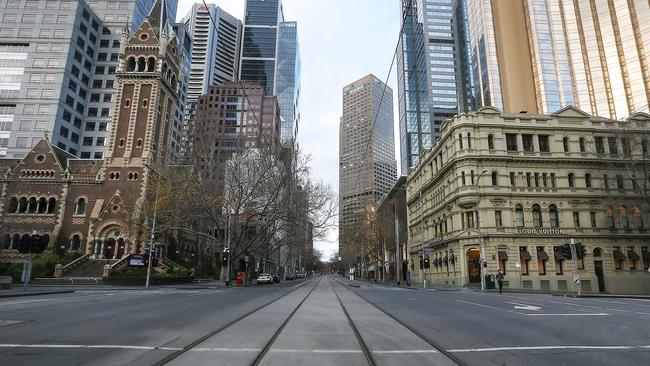Sharp drop in immigration to hit economy
Australia’s resilience in past economic crises owed much to an open-door immigration policy. The coronavirus pandemic has kicked that pillar away.

Australia’s resilience in past economic crises owed much to an open-door immigration policy that drew skilled workers to its cities, students to its colleges and manual labour to its fields.
By forcing the closure of national borders, the coronavirus pandemic has kicked that pillar away.
Prime Minister Scott Morrison said Australia could add as few as 36,000 people from net immigration in the 12 months to June 2021 under arrangements that only allow Australians and permanent residents stranded overseas to return home.
That compares with a forecast of 168,000 net immigrants in the year ended June 30 — itself choked by a period of border shutdown — and 239,600 in the 12 months before that.
“This is a huge hit,” said Shane Oliver, chief economist at AMP Capital. If this occurs, the country’s population growth in the 12 months to June 2021 would be just 0.7 per cent, the lowest since 1917.

Australia had been on a 28-year run without a recession when the pandemic struck. Its economy is now expected to shrink over two consecutive quarters, ending that streak.
Immigration matters because it can swell the workforce, drive spending on infrastructure such as schools and hospitals, and make people feel wealthier by fuelling house prices. How Australia copes with less immigration may offer lessons for other economies that have closed borders.
Australia’s population grew by 1.4 per cent in 2019, government data show. The population at the end of December totalled 25.5 million, representing a 349,800 increase from a year before.
Natural increase — when births exceed deaths — accounted for roughly 40 per cent of the population growth in Australia, with net immigration contributing 60 per cent. That is a heavier dependency on immigration than in the US, where natural increase accounted for 62 per cent of the population uplift in the same year.
Stephen Halmarick, chief economist at Commonwealth Bank, saw little prospect of borders reopening fully until well into 2021.
He said the steep drop in population growth would be felt widely — from education and tourism to agriculture and retail.
A breakdown of the data illustrates this point. Temporary visa holders accounted for 64 per cent of annual net migration from abroad in the year to June 2019, half of which were students.
After Australia banned Chinese arrivals on February 1 to stem the spread of coronavirus, more than 100,000 Chinese students didn’t return. The ban was extended in March to arrivals from the rest of the world other than Australian passport holders and permanent residents. Foreign education is Australia’s fourth-largest export, worth about $US20bn ($28bn) a year.
Tom Kennedy, an economist at JP Morgan, said the impact of fewer foreign students on the economy would likely be felt even after their classes were due to wrap up. That is because many later take up permanent residency and settle in the country.
The outlook for residential construction is also worsening. An apartment boom, focused on suburbs of Sydney and Melbourne popular with immigrants, was ebbing when the pandemic hit. National Australia Bank said slower population growth could mean 190,000 fewer homes need to be built than forecast.
Some economists predict Australian house prices will fall by 10 to 20 per cent in the next year as demand slackens and homeowners spend less on everything from renovations to new cars.
Roman Pazniewski, a 63-year-old home builder in northern Sydney’s upmarket beachside suburbs, has seen his work pipeline shrivel to just one job, well short of the five to six commitments needed to break even.
“The outlook is grim,” said Mr Pazniewski, who recently laid off half of his staff.
Moreover, the pandemic could curb the rate of natural population increase, creating a double whammy for the economy. In vitro fertilisation clinics in Australia were temporarily shut this year, part of a suspension of non-urgent elective surgery as health officials prepared for more COVID-19 cases.
Deloitte Access Economics said a severe economic downturn could lead families to delay or forego having children, driving the fertility rate down to 1.5 births per woman by 2023. That compares with a rate of 1.74 in 2018.
Mr Kennedy estimated that net migration will contribute 0.5 of a percentage point to gross domestic product in the current fiscal year, down 1 point from the five-year annual average. “These are meaningful downshifts and in normal times would garner much attention,” he said.
Capital Economics estimated the border closure would reduce Australia’s potential GDP growth by as much as 1 percentage point for as long as it lasts.
Mr Morrison said the drop in net immigration was likely to be temporary.
He hasn’t put a date on when the borders reopen. However, politicians scaled back tax incentives for foreign workers after the 2008 financial crisis and Mr Morrison’s government last year lowered Australia’s annual immigration cap by 15 per cent.
With Australia’s economic recovery looking more like a “swoosh” than a V shape, and with the unemployment rate at 7.4 per cent, unions may agitate for less immigration to protect jobs and support wages. That could stifle population growth even after the border reopens.
“From a political perspective, it’s not hard to see how the combination of a weaker labour market, tighter border control and a push toward greater economic sovereignty may force a rethink of Australia’s approach to migration policy in the coming decade,” Mr Kennedy said.
The Wall Street Journal




To join the conversation, please log in. Don't have an account? Register
Join the conversation, you are commenting as Logout